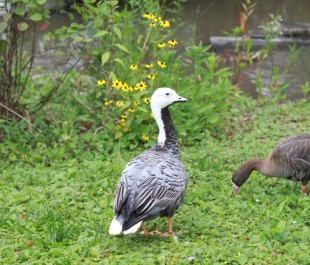Emperor Goose
Emperor geese feature an entirely white head with a black chin & throat, and the rest of the body covered in a plumage of black and white feathers. Their beaks are short and light pink and exhibit bright orange webbed feet.
Range & Habitat
Anser canagicus is restricted to the Bering Sea, breeding within the Artic and the subarctic regions of Alaska, United States and the north-east coastal regions of Russia, during the winter seasons, they are found along the ice-free coastal regions of Canada, Aleutian Islands, & Alaska Peninsula. Nest sites are found within salt marshes and mudflats.
Conservation Status: Near Threatened
Population trend: decreasing. This species has suffered a rapid decline due to subsistence hunting and coastal oil pollution. Unfortunately, it is expected to undergo a population reduction due to climate change.
Diet
Emperor geese feed prominently on intertidal vegetation and marine invertebrates. They are seen to eat seaweed, eelgrass, and sea lettuce. During the autumn and spring months their diet consist mostly of blue mussels and macoma clams. During nesting seasons, the geese feed on grasses, sedges, and bulbs.
Life Span
Fun Facts about the Emperor Goose
- This species of goose is highly preyed upon, the adults mainly by foxes and eagles, while juveniles & eggs are at most rick by foxes, glaucous gulls, golden eagles, snowy owls, mink and sandhill cranes.
- Migration distances traveled between the species wintering and nesting sites range from 650 to over 2500 km.
- Emperor geese nests are commonly parasitized by other bird species. Birds and other emperor geese lay their eggs within other pair’s nests, and if successfully laid, the pair is highly likely to accept the egg as their own.
- Emperor geese are monogamous and will only bond with another goose if their partner dies.
Sources
BirdLife International. 2016. Anser canagicus. The IUCN Red List of Threatened Species 2016: Anser canagicus (Emperor Goose) (iucnredlist.org). retrieved on August 19, 2021.
Emperor Goose. Animalia. Emperor Goose - Facts, Diet, Habitat & Pictures on Animalia.bio. retrieved August 19, 2021.


